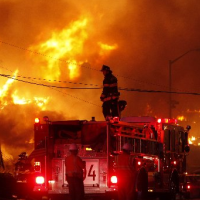Proposed $2.25 Billion PG&E Penalty for San Bruno Blast Decried as Too Big and Too Small
 San Bruno fire after a gas line exploded (photo: Brant Ward, San Francisco Chronicle)
San Bruno fire after a gas line exploded (photo: Brant Ward, San Francisco Chronicle)
At first glance, the California Public Utilities Commission (CPUC) staff recommendation that Pacific Gas & Electric (PG&E) be penalized $2.25 billion for the deadly 2010 San Bruno pipeline explosion seemed tough, almost harsh—a record levy that drew howls of protest from the utility’s CEO.
Similar wounded outcries could also be heard from the city of San Bruno, families of blast victims and advocates for safety and utility reform, according to the San Francisco Chronicle. They don’t like the staff recommendation (pdf) to the commission that all the funds be used to rebuild PG&E infrastructure, repair work it should have been doing all along.
San Bruno officials want PG&E to spend $1 billion on system improvements and pay a $1.2 billion fine to the state General Fund that makes it clear that the penalty for screwing up a job isn’t that you get to do it again. An advocacy group, The Utility Reform Network, “is demanding” that PG&E pay a $720 million fine on top of $1 billion for the system.
PG&E says it has already done enough. CEO Tony Earley said in a statement that the CPUC staff recommendations “far exceed anything that I have seen in my 30 years in the industry and fail to appropriately account for the actions taken by the company.”
The $2.25 billion recommended by the staff includes money that the utility has already been ordered to spend on repairs, a number in dispute. PG&E would get some tax breaks because of the capital investments and the money would come from shareholders, not ratepayers.
The press release (pdf) announcing the long-expected staff report never mentions a fine, only a penalty. The staff report expresses concern that PG&E would be financially harmed by a substantial fine: “CPSD recognizes that there is a limit on how much PG&E can afford to pay, because PG&E needs to retain its creditworthiness.”
PG&E has operating revenue of more than $15 billion and profit of nearly $1 billion. Around 400 plaintiffs have brought civil actions against the company for the blast that killed eight people and razed a neighborhood.
The report also expresses discomfort in setting a value on human life, or at least calling that value a fine: “How much is a human life worth? . . . In our culture human life is priceless. There is no fine large enough to recoup a human life, much less 8 lives.”
Fines, after all, are normally used to “effectively deter further violations by this perpetrator or others.” Some might argue, including the CPUC staff itself, that that principle might apply to PG&E.
The 70-page report is highly critical of the utility and its regulator, the CPUC, as both being culpable in the explosion that “was entirely preventable.”
“The CPUC itself must recognize its contribution to the lax safety culture that directly led to the unsafe conditions resulting in the explosion. PG&E was not operating safely, and we at the CPUC did not do enough to spot this.”
A couple of administrative judges will weigh in with their recommendations before the 5-member commission reaches a decision, possibly late this summer.
–Ken Broder
To Learn More:
State: Fining PG&E “Does Not Make Sense” (by Jaxon Van Derbeken and David R. Baker, San Francisco Chronicle)
San Bruno Pipeline Blast: Agency Says PG&E Should Pay $2.25 Billion (by Garance Burke, Associated Press)
State Regulators Propose that PG&E be Punished with a Record $2.25 Billion Penalty for San Bruno Blast (by Pete Carey and George Avalos, San Jose Mercury News)
Record $2.25-Billion Fine Recommended in Deadly San Bruno Blast (by Kate Mather, Los Angeles Times)
PG&E Says San Bruno Blast May Cost $1 Billion; State Says It Can Afford Twice That (by Ken Broder, AllGov California)
Opening Brief of the Consumer Protection and Safety Division (California Public Utilities Commission) (pdf)
- Top Stories
- Controversies
- Where is the Money Going?
- California and the Nation
- Appointments and Resignations
- Unusual News
- Latest News
- California Forbids U.S. Immigration Agents from Pretending to be Police
- California Lawmakers Urged to Strip “Self-Dealing” Tax Board of Its Duties
- Big Oil’s Grip on California
- Santa Cruz Police See Homeland Security Betrayal in Use of Gang Roundup as Cover for Immigration Raid
- Oil Companies Face Deadline to Stop Polluting California Groundwater





